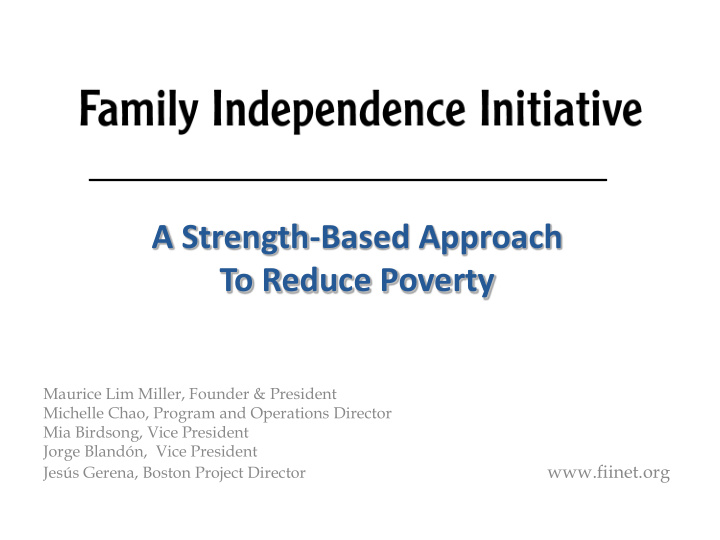



Nota A Strength-Based Approach To Reduce Poverty Maurice Lim Miller, Founder & President Michelle Chao, Program and Operations Director Mia Birdsong, Vice President Jorge Blandón, Vice President www.fiinet.org Jesús Gerena, Boston Project Director
Founded on Core Principles Current Initiatives “Natural” Anti -Poverty Contradict “Natural” Process Process Already Exists FII is a social lab & advocate that adapts historical approaches to help the working poor advance their lives
Filling a Critical Gap $ benefits Federal benefits for home TOP DOWN: TANF (welfare) ownership, savings, $20K Policies to promote investments & business EITC family initiative development * Food stamps $10K Middle income Service Workers, laborers, etc. BOTTOM UP: FII Families Family capacity to Upper income Median $26,000 self-organize & make progress $28,000 = 130% $50,000 $22,000 $80,000 Poverty Level Household Income (Family of 4)
Program Model: Bottom Up Two-year, FII-facilitated engagement with groups of families to catalyze change Program Structure Activities • Families enrolled with friends “Core Family Catalyst • Each family given computer & trained to Families” report progress online Family Family FII liaison • Require monthly group meetings & qtrly family meeting to audit reported progress • Provide awards for reporting progress & Family Family providing documentation ~ $25 per activity • Provide match to savings families make for business, home or education • Provide funding for activities or training “Ripple families self organize Families”
Direct Outcomes: Earnings & Assets Families have demonstrated significant near- and long- term economic gains as well as a host of other outcomes that show increased control over their life trajectories Audited Outcomes Within Two Years in FII n= 86 Families(Oakl, S.F., Hi ) Oakland Average Family Income Metrics Outcomes n= 52 Families (4.6 members/family) Earning % increase in income 23% 27% increase $28,400 % increase in savings 240% $19,000 # of new homeowners 15 Asset- $5,800 $3,200 Building # of new businesses 19 Before FII After FII # of expanded businesses 9 Government Benefits Earned Income Examples of Other Outcomes: Child Grades Improved Families Left Welfare Earnings Continued Up in Post Surveys, etc.
Policies & Practices • Rebuilding sense of community/mutuality – Fund volunteer programs where neighbors help neighbors – Homeownership programs allowing combined family ownership • Cross class mutual support – Person to person lending: KIVA & Prosper.com – Social networking platforms & meet ups on issues of interest • Surfacing informal economy, creating jobs – Self employment tax credits – Underwriting criteria that puts weight on “character” history • Support parent/guardian initiated educ. initiative – Match to dollars raised by parents for scholarships, etc – Community awards to youth/parent involvement in schools
Self Sufficiency is Gaining CONTROL over your life & having CHOICES for the future • Focus on developing social and economic assets • Families control the process of change from the beginning • Behavioral Studies show that trusting families to lead their own change and work with friends improves outcomes
National Impact Strategy: Top Down Two- thirds of FII’s resources are dedicated to influencing policy and driving shifts in philanthropic giving to support families taking initiative to improve life circumstances Early Evidence FII Activities of Impact • Create “Poor Person’s Boston & San Francisco Mayors YELP” Policy/ utilize feedback from YELP to reform public services Regulatory • Build network of influential champions Boston Rising and California Endowment shift Influence Funders Philanthropy focus based on FII premises
How FII Obtains Data/Feedback Each Household Is Given Family Gatherings A Computer Baseline & Monthly FII Obtains Stories, Data Opinions, Experiences Survey Feedback Data • Over 230 data points captured on-line at enrollment and changes or progress is captured monthly Reported Data is Audited Quarterly for accuracy
Sample of Data Income & Health & Education & Resourceful & Networks & Balance Sheet Housing Skills Leading Helping Sources of Income Youth Insurance Coverage Attends Trainings Expands Job Networks Checking & Savings Grade Improvement Preventative Care Shares their Training Refers Friend to Job Balance - Checkups Attendance - Immunizations Involved/Leads Civic Helps Others Starting Business Ownership Activities Businesses, etc. Tutoring Behavioral Retirement Accounts Changes/Outcome Attends Leadership Refers Friends to After School Program - Weight loss Workshops Needed Resources Credit Card - Quits smoking Payments/Balance Graduation Gets FII Fellowship & Helps Those in Crisis Improved Housing Leads Activities Rent/Mortgage Adults Recruits, Orients New Payments Home Ownership Families Classes Outstanding Mortgage Continuing Education Graduation
Analysis of Sample Income & Employment Income Government Sources Balance Sheet Formal Income Food Stamps Total Monthly Income Formal Self- Calworks Sources of Income Trend and Effects Employment Unemployment Informal Income SSI Checking & Savings Balance Business Ownership Retirement Accounts Credit Card Payments/Balance Rent/Mortgage Payments Outstanding Mortgage
Recommend
More recommend